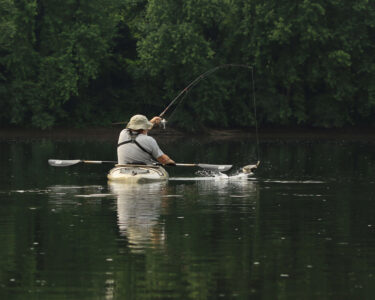With all the rain, be careful when wading streams, waterways
Whether exploring a mountain stream for native brook trout or the Susquehanna River for smallmouth, one of my favorite summer fishing methods is wading. Wading is easy, allowing a minimalist approach and, due to the warm temperatures, it’s not necessary to wear waders.
Additionally, the typically low water levels allow access to areas that would otherwise be inaccessible for fishing. But not this year.
Due to the seemingly endless rain the Commonwealth has received this summer, which has made it feel more like a warm spring, many streams are running higher and faster than usual. Some are downright unsafe, even with a kayak or small boat.
Others although still accessible take wading to a new level of risk, and if you are not adequately prepared, it can be potentially deadly.
Water is more powerful than many people realize. Even sportsmen who spend most of the year on or in the water underestimate the power of moving water. This is a grave mistake and one that is responsible for more accidents than it should be.
Six inches of moving water can knock a full-grown adult off their feet.
Two feet of moving water can carry away a full-size truck or SUV.
If the waterway you are attempting to cross or wade is at or near flood conditions, you should never try to enter it. Not only is there a danger of being swept away, but there is likely unseen debris being pushed by the flood conditions that can injure or kill you.
However if the water is above normal flow, but still far below flood conditions, it is possible to wade and fish safely if you take some precautions.
The first thing you want to do is survey the area and make a realistic evaluation of conditions and your ability to deal with them. Everyone has limitations, and even a few inches above regular levels can make your favorite stream unsafe. While conducting your survey, especially after a highwater event, pay special attention to new debris that may be in the area or scouring that may have changed the stream bottom.
If anything looks suspicious or out of your comfort zone, move on. Finding a different spot or fishing from shore is always better than being stuck in one place and drowning.
If you plan to wade, ensure you have the right equipment. While I love to wade in shorts and sandals with a simple pack of tackle, this may not be the right time. Wading boots with extra traction, a walking staff and a personal floatation device may not be as comfortable as you desire. But each of these pieces of equipment can save your life.
The wading boots will provide extra traction, the staff improves balance and allows you to probe for unexpected holes and the PFD’s benefits are self-explanatory. If you are wearing waders, be sure to include a belt, as it will help keep you from taking on extra water should you slip.
When moving through the water, avoid heading straight for your spot or the far bank. Instead, move at a slight angle as this will prevent the full force of the water from hitting you directly.
Shuffle, do not step. Although this is not always possible, shuffling will always allow you to maintain contact with the bottom, lessening the chance of losing your balance. If you need to step over a rocky area, using a staff will allow you to have a third point of contact with the ground and ensure two points of contact even when stepping.
Avoid the obstacles. Large rocks, logs, or other hazards can be challenging to cross under normal conditions. Trying to do so in faster water can be the difference between fishing and swimming.
If you do fall, do not panic. Attempt to stand up, use your walking staff to help regain your footing, and move to a slower area. If you cannot stand, swim with the current, not against it. Angle yourself toward the shore or shallow water and stand when it is safe to do so.

